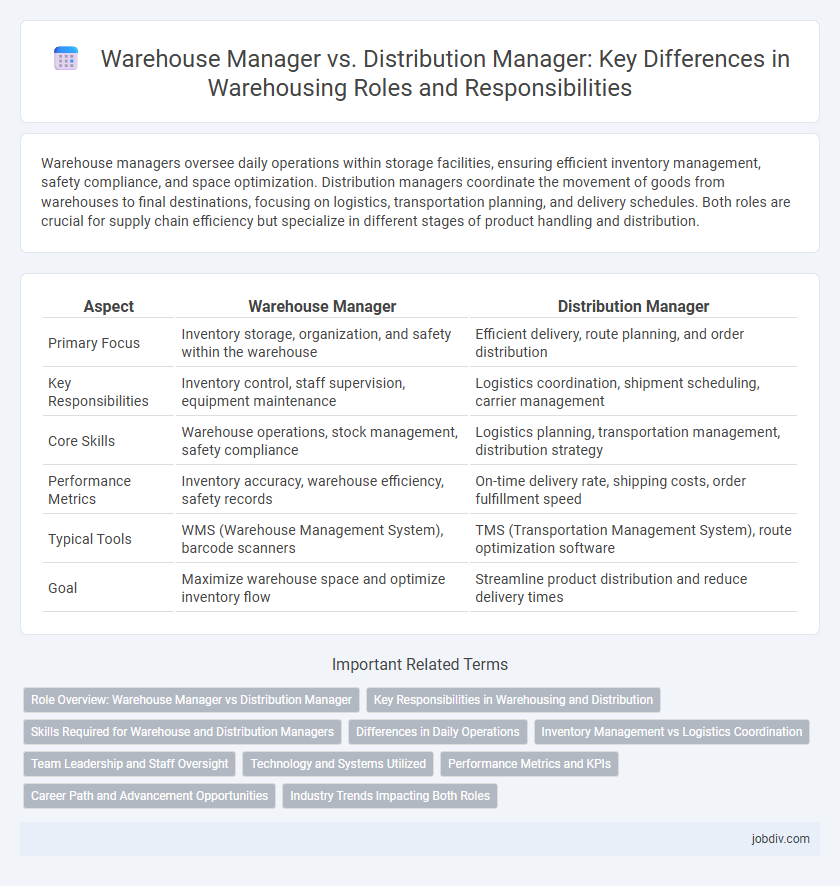Warehouse managers oversee daily operations within storage facilities, ensuring efficient inventory management, safety compliance, and space optimization. Distribution managers coordinate the movement of goods from warehouses to final destinations, focusing on logistics, transportation planning, and delivery schedules. Both roles are crucial for supply chain efficiency but specialize in different stages of product handling and distribution.
Table of Comparison
| Aspect | Warehouse Manager | Distribution Manager |
|---|---|---|
| Primary Focus | Inventory storage, organization, and safety within the warehouse | Efficient delivery, route planning, and order distribution |
| Key Responsibilities | Inventory control, staff supervision, equipment maintenance | Logistics coordination, shipment scheduling, carrier management |
| Core Skills | Warehouse operations, stock management, safety compliance | Logistics planning, transportation management, distribution strategy |
| Performance Metrics | Inventory accuracy, warehouse efficiency, safety records | On-time delivery rate, shipping costs, order fulfillment speed |
| Typical Tools | WMS (Warehouse Management System), barcode scanners | TMS (Transportation Management System), route optimization software |
| Goal | Maximize warehouse space and optimize inventory flow | Streamline product distribution and reduce delivery times |
Role Overview: Warehouse Manager vs Distribution Manager
A Warehouse Manager oversees inventory storage, organization, and safety within the facility, ensuring efficient use of space and accurate stock levels. Distribution Managers focus on coordinating the movement of goods from the warehouse to the final destination, optimizing transportation, delivery schedules, and logistics operations. Both roles are critical for supply chain efficiency, with the Warehouse Manager emphasizing internal handling and the Distribution Manager managing external distribution networks.
Key Responsibilities in Warehousing and Distribution
Warehouse Managers oversee inventory control, storage optimization, and daily operations to ensure efficient warehouse functionality and product accuracy. Distribution Managers focus on transportation management, order fulfillment, and logistics coordination to guarantee timely delivery and supply chain fluidity. Both roles are crucial in streamlining the flow of goods but prioritize internal warehouse efficiency versus outbound delivery processes, respectively.
Skills Required for Warehouse and Distribution Managers
Warehouse Managers require expertise in inventory control, space optimization, and safety compliance to efficiently manage storage facilities and ensure seamless operations. Distribution Managers need skills in logistics coordination, transportation management, and demand forecasting to optimize the flow of goods and meet delivery timelines. Both roles demand strong leadership, problem-solving abilities, and proficiency with warehouse management systems (WMS) and enterprise resource planning (ERP) software.
Differences in Daily Operations
Warehouse Managers oversee inventory control, storage systems, and the organization of stock within the facility to ensure efficient space utilization and accurate record-keeping. Distribution Managers coordinate the outbound logistics, managing transportation schedules, order fulfillment, and delivery timelines to optimize the flow of goods to customers. The primary operational difference lies in Warehouse Managers focusing on internal stock management processes, while Distribution Managers handle external shipping and distribution networks.
Inventory Management vs Logistics Coordination
Warehouse Managers oversee inventory management by ensuring accurate stock control, efficient storage solutions, and timely replenishment to maintain optimal warehouse operations. Distribution Managers focus on logistics coordination, managing transportation, delivery schedules, and route optimization to facilitate smooth distribution channels. Both roles are crucial in supply chain efficiency, with Warehouse Managers centering on inventory accuracy and Distribution Managers prioritizing the seamless movement of goods.
Team Leadership and Staff Oversight
Warehouse Managers excel in team leadership by directly supervising warehouse staff, coordinating daily operations, and ensuring efficient inventory management. Distribution Managers oversee broader staff roles, focusing on coordinating logistics teams and managing the flow of goods from the warehouse to final destinations. Both roles require strong leadership skills, but Warehouse Managers emphasize hands-on team oversight, while Distribution Managers prioritize strategic staff coordination across multiple distribution channels.
Technology and Systems Utilized
Warehouse managers primarily utilize warehouse management systems (WMS) to optimize inventory control, order fulfillment, and space utilization, ensuring smooth internal operations. Distribution managers rely heavily on transportation management systems (TMS) and advanced route optimization software to coordinate efficient product delivery and logistics across multiple channels. Both roles integrate technologies like RFID, automated guided vehicles (AGVs), and real-time data analytics, but their focus diverges between in-facility process automation and external supply chain coordination.
Performance Metrics and KPIs
Warehouse Managers primarily track inventory accuracy, order fulfillment rates, and storage utilization to optimize in-facility operations. Distribution Managers focus on delivery lead times, transportation costs, and on-time shipment percentages to enhance supply chain efficiency. Both roles utilize KPIs like cycle time and labor productivity to measure performance but target different stages of the supply process.
Career Path and Advancement Opportunities
Warehouse Managers typically advance from roles such as Inventory Supervisors or Logistics Coordinators, gaining expertise in inventory control, staff management, and operational efficiency. Distribution Managers often progress from Warehouse Manager or Supply Chain Analyst positions, expanding their responsibilities to include transportation logistics, route optimization, and end-to-end supply chain management. Career advancement for Warehouse Managers leads to Distribution Manager roles, while Distribution Managers can move into senior supply chain leadership positions such as Director of Logistics or Vice President of Operations.
Industry Trends Impacting Both Roles
Industry trends such as the rise of e-commerce, automation technologies, and data-driven supply chain management are reshaping the responsibilities of both Warehouse Managers and Distribution Managers. Warehouse Managers increasingly emphasize inventory accuracy and warehouse automation to optimize storage and picking processes. Distribution Managers focus on last-mile delivery efficiency and integrating real-time logistics tracking to meet consumer demand for faster, flexible shipping options.
Warehouse Manager vs Distribution Manager Infographic

 jobdiv.com
jobdiv.com